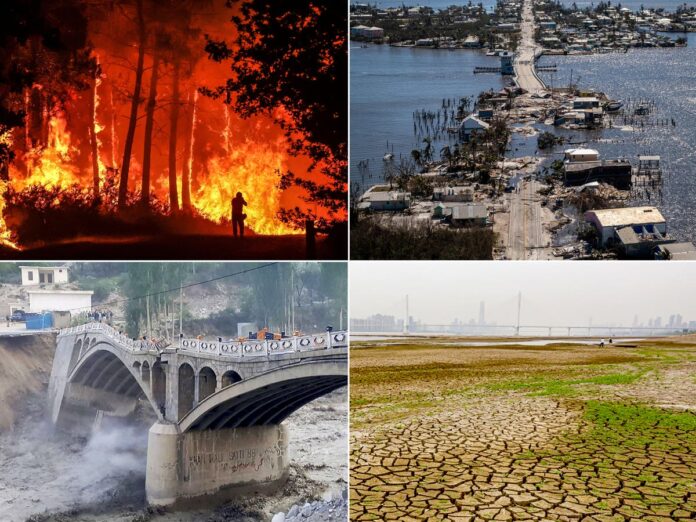There is ‘no credible’ pathway in place to rein in global temperature rise to 1.5C degrees, the United Nations warned today – and that only ‘root and branch’ can save the planet from disaster.’Under current policies, the world is headed for 2.8 degrees of global heating by the end of the century,’ said UN Secretary-General, Antonio Guterres, outlining the findings of the landmark report. ‘In other words, we are headed for a global catastrophe.’It was yet another dismal assessment of the state of the climate crisis with a little over a week to go until the next international climate summit, Cop27, in Egypt.The last Cop26 in Glasgow had a key goal of ‘keeping 1.5 alive’ but the latest findings pour cold water on achievements since then.’Progress since COP26 in Glasgow has been woefully inadequate,’ the UN Emissions Gap report reads.The yearly update offers an independent take on countries’ combined efforts to cut greenhouse gas emissions. The report, titled The Closing Window, doesn’t make for happy reading.Despite a decision by all countries at COP26 last November in Glasgow to make more drastic emissions cuts – called Nationally Determined Contributions (NDCs) – very little has been done. NDCs submitted in the past year tack less than 1 per cent, off projected global emissions in 2030.Firefighters operate at the site of a wildfire in Pumarejo de Tera near Zamora, northern Spain, in June. If these pledges are implemented the planet is on track to hit 2.4-2.6C by the end of the century, nearing double the limit agreed by countries under the 2015 Paris Agreement to avoid catastrophic impacts of more heat and droughts, stronger storms and ice sheet collapse.The Paris deal saw every country pledge to play its part in cutting emissions to limit temperature rise to 1.5C – or at least ‘well below 2C’ – to avert planetary breakdown.Among other key findings are:Most G20 members have just started acting on new targets -and so are expected to fall short of 2030 promises unless they work fasterCurrent emission-reduction policies – without further strengthening- are tracking for a 2.8C temperature hike by 2100 If all NDCs are met, plus net-zero commitments, temperature increase is projected at 1.8C. But this scenario is ‘not credible’, the report says’This report tells us in cold scientific terms what nature has been telling us, all year, through deadly floods, storms and raging fires: we have to stop filling our atmosphere with greenhouse gases, and stop doing it fast,’ said Inger Andersen, executive director of the UN’s Environment Program.This aerial photo taken in August shows dry sections of Poyang Lake in Jiujiang in China’s central Jiangxi province. ‘We had our chance to make incremental changes, but that time is over. Only a root-and-branch transformation of our economies and societies can save us from accelerating climate disaster.’The report notes that while net-zero transformations are underway in many sectors, more needs to happen at a faster clip.The UNEP reports lays out plans to get there.For electricity supply, the UN calls for leaning in on solar and wind power, the costs of which have fallen dramatically although they cautioned that more needed to be done to ensure all communities were getting equal access. The report also warned against ‘locking in’ new fossil fuel-intensive infrastructureThe private sector was called upon to cut food loss and waste – a significant source of emissions – use renewable energy and develop foods that have lower carbon footprints.Residents inspect damage to a marina as boats are partially submerged in the aftermath of Hurricane Ian in Fort Myers, Florida, in September. Food systems – the source of one third of all emissions – needs dietary changes, improvements in production at the farm level and decarbonization of supply chains.Buildings, a large chunk of global emissions, need to have ‘available technologies’ fully applied, while industry and transport, need more ambitious efforts to create zero-emission technology, and that which exists deployed at a faster rate.The financial system must overcome ‘constraints’ and come up with investments of at least USD 4-6 trillion a year to drive the shift to a low-carbon economy, a relatively small (1.5-2 per cent) share of total financial assets managed, but significant (20-28 per cent) in terms of additional annual resources needed.’Even if the transformation fails to fully bridge the 2030 emissions gap, every fraction of a degree matters,’ it noted.
Progress since COP26 ‘woeful’ as global heating catastrophe looms, says UN report
Sourceindependent.co.uk
RELATED ARTICLES


